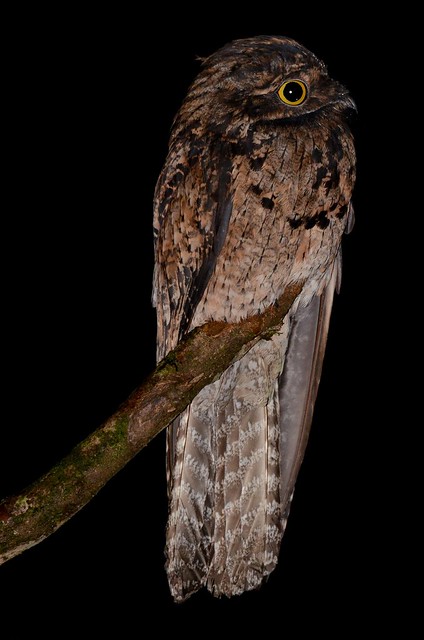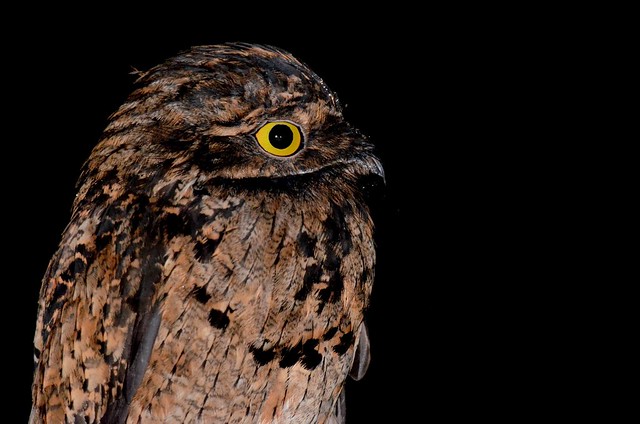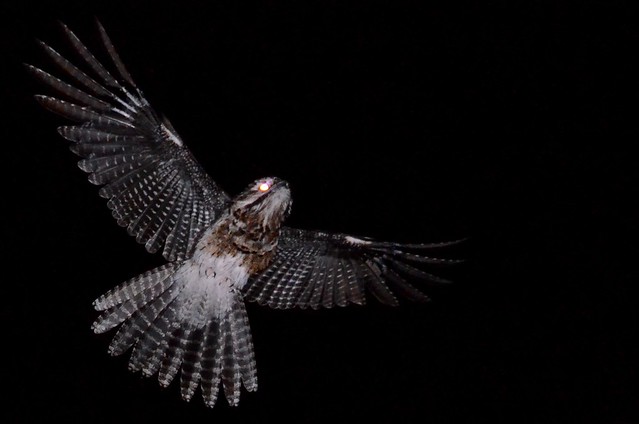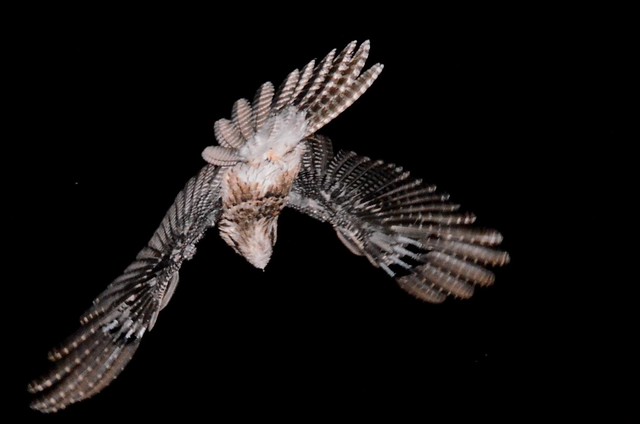One of my favourite things about Rancho is the ability to wander around the jungle at night. There are many odd things to be seen, from Tailless Whip-Scorpions to Crowned Treefrogs. There is however, one creature that I am very fond of that lives at Rancho, and to see it one must know where it sleeps during the day, or, to really see it, go out at night.
The Potoo (pronounced poe-two) is a relative of the nightjars, and like them it comes out at night to feed on large insects such as moths. By day, the bird is incredibly well camouflaged, choosing to perch on a broken-off snag to complete its disguise.
A Common Potoo dayroosting at Rancho. Can you find it?
There are three Potoo species in Costa Rica; the Northern Potoo up in the dry forests of Guanacaste, the enormous Great Potoo down in the lowlands, and the widespread Common Potoo which is the one that we have here at Rancho.
I have seen the Potoo here many times but almost always on the dayroost, when the bird looks like a shapeless mass of feathers atop a snag. Many of us have seen owls on the dayroost and those who've seen the same birds active at night know that they look and behave completely different - as do people. You wouldn't get an accurate idea of how somebody looks if you just see them asleep (which would be somewhat strange, anyhow...)
I wanted to get to know the real Potoo so I went out on a full moon night, when the bird is active all night long (rather than on half or new moons, when they're only foraging actively for a couple of hours before dawn and after dusk) and tried to find one.
The Potoo transforms from the shapeless mass it was during the day to a huge-eyed, long-tailed ambush predator.
The beak is small, but the net-like gape is enormous and the bird is capable of swallowing enormous moths, such as Rothschildia, which form the mainstay of its diet. Rictal bristles, the hair-like feathers at the base of the mouth, help direct their prey where it should go.
Potoo's song is something to behold. The male, during full moons, emit the most eerie, thrush-like series of descending whistles that undoubtedly scared the living daylights out of early explorers and still scare unknowing nighttime jungle visitors today.
I sat there and watched the bird, fondly remembering the first time I'd read about them in Wild America, when James Fisher and Roger Peterson briefly went to Mexico with Bob Newman and collected a bird hunting moths alongside a road.
"A tree with eyes. Suddenly the dead tree's head detached itself and the eyes disappeared in a silent flutter of wings and tail...One shot was all that was necessary; the big bird dropped to the foot of the tree without a sound. We were able to examine it in the flesh, its great eyes, now dim, and its immense veined pink throat, cavernous enough to swallow small birds."
I at this point in time imagined it being an almost mythical fantasy bird, in the deep, dark jungles where few have ever explored and I thought I would never lay eyes on one. Collecting was always one of those activities that I associated with exploration and adventure, and I'd always wanted to be that explorer. This experience brought me back to that moment.
I aimed straight at the stolid Potoo on the branch. Save for looking around occasionally, the bird remained still. One shot was all that was necessary.
The beak is small, but the net-like gape is enormous and the bird is capable of swallowing enormous moths, such as Rothschildia, which form the mainstay of its diet. Rictal bristles, the hair-like feathers at the base of the mouth, help direct their prey where it should go.
Potoo's song is something to behold. The male, during full moons, emit the most eerie, thrush-like series of descending whistles that undoubtedly scared the living daylights out of early explorers and still scare unknowing nighttime jungle visitors today.
I sat there and watched the bird, fondly remembering the first time I'd read about them in Wild America, when James Fisher and Roger Peterson briefly went to Mexico with Bob Newman and collected a bird hunting moths alongside a road.
"A tree with eyes. Suddenly the dead tree's head detached itself and the eyes disappeared in a silent flutter of wings and tail...One shot was all that was necessary; the big bird dropped to the foot of the tree without a sound. We were able to examine it in the flesh, its great eyes, now dim, and its immense veined pink throat, cavernous enough to swallow small birds."
I at this point in time imagined it being an almost mythical fantasy bird, in the deep, dark jungles where few have ever explored and I thought I would never lay eyes on one. Collecting was always one of those activities that I associated with exploration and adventure, and I'd always wanted to be that explorer. This experience brought me back to that moment.
I aimed straight at the stolid Potoo on the branch. Save for looking around occasionally, the bird remained still. One shot was all that was necessary.
Now all of you readers can see those same huge eyes, vivid yellow and full of life.
I watched another Potoo, a more active one, the other night. This bird was a hatch-year bird - aged by looking at the primaries, which were still in pin! This is how vital flight is this bird, and all the nightjars - they start to fly even before their wing is fully feathered. I was following this particular birds' fledging from when it was just a fluffball on a stick when I was still in Canada.
And when they do fly, they are long-winged torpedos, far from the shapeless dayroosting birds.
It grabbed a moth in mid-air and turned around.
Then, it returned back to its original perch, like a massive nocturnal wood-pewee. I have seen the Potoo many times, but seeing one actively hunting at night was incredible.
What else was incredible, was the fact that this very bird that I dreamed of through James' and Roger's book was hunting in my front yard.






No comments:
Post a Comment